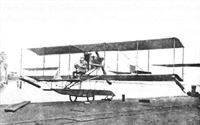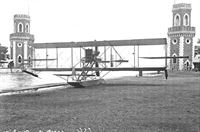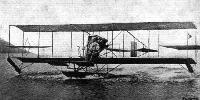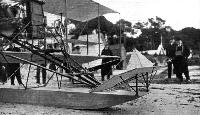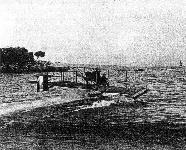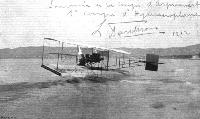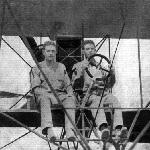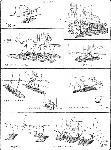А.Шепс Самолеты Первой мировой войны. Страны Антанты
Первым гидросамолетом Глена Хаммонда Кертисса стал поплавковый вариант сухопутного самолета "Голден Баг", который был принят на вооружение ВМС США под обозначением "U.S. Navy Airplane". Эта машина стала основным учебным самолетом для американских летчиков в начальный период формирования морской авиации в 1909-1910 годах. 14 ноября 1910 года Юджин Эли совершил взлет на колесном варианте А-1 со специальной надстройки в носовой части крейсера "Бирмингем", а 18 января 1911 года успешно приземлился на платформу крейсера "Пенсильвания". Успешные полеты смелого американского летчика предопределили появление палубной корабельной авиации.
Показать полностью
В.Шавров История конструкций самолетов в СССР до 1938 г.
"Кертис" поплавковый ( "Кертис Ф" ). Этот самолет был в трех модификациях, одинаковых по размерам: одноместный с двигателем "Кертис" в 65 л. с. и двухместный с тем же двигателем в 85 л. с. Появились они в России в 1912 г. Всего было на Черном море семь экземпляров, летавших до осени 1915 г.
В отчетах морской авиации Черного моря имеется большой материал об их применении в боевых операциях у турецких берегов. Самолеты эти брались на корабли, спускались оттуда на воду, а затем они совершали полеты с целью разведки и сбрасывания бомб.
"Кертис-амфибия" ("Амфибия Фирсова" ) - тот же двухместный вариант, но с колесами и без подъемного устройства. Колеса несколько затрудняли взлет. Самолет появился в Севастополе в 1911 г. в одном опытном экземпляре. На нем летал поручик В. Н. Фирсов.
Самолет||//
Год выпуска||1911/1911/1911
Двигатель, марка||//
Мощность, л.с.||65/85/85
Длина самолета, м||8,4/8,4/8,4
Размах крыла, м||8,73/8,73 (11,3)/8,73
Площадь крыла, м2||28,5/28,5/28,5
Масса пустого, кг||430/460/480
Масса топлива+ масла, кг||70/90/90
Масса полной нагрузки, кг||150/250/250
Полетная масса, кг||580/710/730
Удельная нагрузка на крыло, кг/м2||20,4/25/25,6
Удельная нагрузка на мощность, кг/лс||8,9/8,4/8,6
Весовая отдача,%||26/35/34
Скорость максимальная у земли, км/ч||70/75/75
Скорость посадочная, км/ч||65/70/70
Время набора высоты 1000м, мин||30/25/30
Потолок практический, м||?/1700/?
Продолжительность полета, ч.||3/3/3
Показать полностью
P.Bowers Curtiss Aircraft 1907-1947 (Putnam)
Seaplane Development
The first American attempt to fly from the water was made by the AEA in 1908 with the Loon, but it was unable to take off. In June 1910, Curtiss successfully alighted on Lake Keuka in a Type III pusher with a canoe secured beneath it; however, the aeroplane would not take off for the same reason as the Loon - the high hydrodynamic drag of the rounded canoe hull prevented the machine from reaching flying speed.
Curtiss soon realized that a flat-bottomed float could plane over the water, offering less drag and consequently more speed for a given power. A long series of experimental pontoons, or floats, was then developed and tried on standard Curtiss pushers at San Diego during winter 1910-11.
Although the Frenchman Henri Fabre had successfully taken off from water in a powered aeroplane on 28 March, 1910, Curtiss is recognized as the inventor of the practical seaplane. The original short Curtiss floats had flat bottoms for their entire length; later, long designs featured the hydroplane step, located slightly behind the aeroplane's centre of gravity, that Curtiss had developed for his flying-boat in 1912, combined with V-bottoms.
The single main float with wingtip floats standardized by Curtiss early in 1911 remained in use on most US Navy seaplanes to the end of their service in 1960; the twin-float arrangement of the 1908 Loon is in universal use on civil seaplanes today.
Experimental Hydros, 1911
The first successful flight of what was originally called a hydroaeroplane or simply hydro, but is now known as a seaplane, was made on 26 January, 1911. It used a clumsy tandem-float arrangement featuring a main float six ft (1.82 m) wide by five ft (1.52 m) long under the centre section, a smaller float forward, and a hydrofoil ahead of that to keep the bow from submerging at high speed. The wide design of the main float served two purposes. By being wide it was expected to function as an auxiliary wing to generate useful lift; also, its width would keep the spray pattern well outboard of the pusher propeller. Being short, it did not provide longitudinal stability on the water thus necessitating the forward float.
By 1 February, a new arrangement was introduced, comprising a sled-shaped single float 12 ft (3,65 m) long, two ft (60 cm) wide and a foot (30 cm) deep, under the pilot and engine to provide longitudinal stability; small floats for lateral stability were under the wingtips.
At first, the main float was not compartmented. On a flight at Hammondsport, Curtiss took off in a hydro but a considerable amount of water had got into the float and as he nosed down to alight, all the water ran to the bow of the float and made the machine so nose heavy that Curtiss was unable to raise the nose and crashed into the lake. He recognized the problem as soon as it appeared and fortunately survived to correct it.
An early refinement of the hydro was to eliminate the booms that supported the forward elevator and place a monoplane elevator on the bow of the float. As on contemporary landplanes, the hydro's forward elevators were soon eliminated.
Tractor Hydro. The second Curtiss hydro was a notable exception to the standard pusher design. The un-named machine that Curtiss used for his flight from North Island to the cruiser Pennsylvania was an otherwise standard Type III pusher airframe with the engine installed ahead of the wing as a tractor to keep the propeller out of the spray. The pilot was seated behind the wings and the forward elevator was eliminated. Curtiss didn't like the arrangement mainly because of the discomfort of sitting in the propeller blast and engine exhaust; the problem of spray on the propeller on subsequent pusher seaplanes was reduced somewhat by the addition of horizontal spray deflectors to the top of the main float ahead of the propeller.
Triad. With the conventional landplane converted to water operations by the substitution of pontoons for wheels, it was only natural to develop an aeroplane to operate from both elements. Curtiss achieved this by adding retractable wheels under the lower wings of a hydro and adding a nosewheel to the bow of the float. The resulting amphibian, named Triad by Curtiss, was successfully demonstrated at North Island on 25 February, 1911.
Although still in use today, the popularity of amphibious floatplanes has always been limited by the double weight handicap of the floats and the necessary wheel-retracting mechanism. The most popular amphibians have all been flying-boat types.
US Navy A-1. The Navy's first aeroplane, a 50 hp Curtiss Model E seaplane costing $5,500, was tested by Glenn Curtiss on 30 June, 1911, and turned over to Navy pilot T. G. Ellyson at Hammondsport the same day. On 7 July, the75 hp V-8 engine originally intended for the A-1 was installed. The A-1, later AH-1 under the 1914 Naval designation system, operated as a straight seaplane, as a Triad amphibian, and as a landplane.
Among the experiments undertaken with A-1 were take off down an inclined wire, with a groove in the bottom of the float to maintain alignment, and the Navy's first attempt to launch an aeroplane from a compressed-air catapult. After sixty flights totalling 285 hours, plus numerous rebuilds, A-1 is believed to have been struck off charge on 16 October, 1914.
By the autumn of 1911 Curtiss was advertizing hydros on the open market. The standardized float gear was available for an additional $500 when buying a standard Model D or E land plane. The hydros were nearly as popular as the landplanes and were licensed to overseas manufacturers in 1912.
The US Navy bought fourteen pushers with detail variations between 1911 and 1914. The combined Navy Type I serial numbers were A-1, A-2 (delivered as a landplane but converted to hydro), A-3, A-4, AH-8, AH-9, and AH-11/18. AH-8 was turned over to the Army, was still in Army hands in 1919, and was then stored. It was refurbished for a brief flight on 10 February, 1928. AH-9 was rebuilt and redesignated as an AH-8 type, Navy serial No. A-83.
Показать полностью
G.Swanborough, P.Bowers United States Navy Aircraft Since 1911 (Putnam)
Early Curtiss Pushers
Identifying the various Curtiss pushers supplied to the US Navy from 1911 through 1913 by either a factory or Navy model number is impossible. Curtiss had no firm designation system at the time and the Navy system was very general, applying originally only to manufacturer and sequence of procurement. This was soon changed to a basic type as aeroplane and to subtype, as hydroplane or flying-boat. The first Navy aeroplane was a Curtiss pusher seaplane designated A-1. This was a waterborne version of the basic Curtiss pusher that had been in production since 1909 and which had been developed into the world's first consistently successful seaplane. After several unsuccessful float configurations were tried Glen Curtiss made his first seaplane flight at San Diego, California, on January 26, 1911. It was this ability to operate from water, plus a visit by Curtiss in his seaplane to the battleship USS Pennsylvania anchored off San Diego from a shore station on February 17, 1911, that crystallized the Navy's existing interest in aeroplanes and led to the purchase of the A-1 in July 1911. Earlier, the Navy co-operated with Curtiss in the operation of Curtiss-owned aeroplanes from ships of the fleet. On November 14, 1910, the Curtiss pilot Eugene Ely flew a pusher from a platform rigged on the aft deck of the cruiser USS Birmingham anchored in Hampton Roads, Virginia. Later (on January 18, 1911) he landed aboard and took off from a similar platform built on the battleship USS Pennsylvania anchored in San Francisco Bay.
Lt Theodore G. Ellyson, who had been an official naval observer at Curtiss' first seaplane flight, was sent to the Curtiss Flying School at Hammondsport, NY, to receive flight instruction that qualified him as Naval Aviator No. 1. After the A-1 was test hopped by Curtiss on July 1, 1911, Curtiss took Ellyson up on a familiarization flight after which Ellyson made two more flights alone. After acceptance by the Navy, the A-1 figured prominently in early Naval aircraft developments. One experiment consisted of converting the A-1 to an amphibian, called the Triad, by adding retractable wheels to the float.
Launching methods were given high priority. On September 7, 1911, Ellyson was able to take off in the A-1 from an inclined wire. Directional control was maintained by a groove in the float through which the wire ran. Later, experiments were conducted in which the A-1 was to be launched by a compressed-air catapult based on the successful torpedo launchers then in use by the Navy. The initial trials, undertaken on a dock at Annapolis, Maryland, ended in failure due to the A-1 not being properly restrained. It lifted off from the carriage without control as soon as it gained forward speed. The first successful catapult launch was made by Ellyson in the A-3 at the Washington Navy Yard. The A-1, meanwhile, being the only aeroplane that the Navy had, set an Impressive number of records merely by exceeding its previous performance. With Lt John H. Towers as passenger, Ellyson flew 112 miles from Annapolis, Maryland, to Milford Haven, Virginia, in 122 minutes. The A-1 was the first Navy aeroplane to carry a radio, although without success, and established a seaplane altitude record of 900ft on June 21,1912.
The Curtiss A-1 had a 75 hp Curtiss V-8 engine for most of its 285 flights.
TECHNICAL DATA (A-1)
Manufacturer: Curtiss Aeroplane and Motor Co, Inc, Hammondsport, NY.
Type: pusher biplane, landplane or seaplane.
Accommodation: Pilot and passenger.
Power plant: One 75 hp Curtiss V-8.
Dimensions: Span, 37 ft; length, 28 ft 7 1/8 in; height, 8 ft 10 in; wing area, 286 sq ft.
Weights: Empty 925 lb; gross, 1,575 lb.
Performance: Max speed, 60 mph.
Serial numbers: None.
Показать полностью
H.King Aeromarine Origins (Putnam)
Having failed in 1908 to coax his Loon from the water, Glenn Curtiss was obliged to proceed with his landplanes; but when he made his famous Albany - New York flight in one of these on May 31, 1910, he fitted it with two cylindrical under-wing floats (removed during the stop at Spuyten Duyvil), an airtight canvas bag, running the length of the strut that connected the front and rear wheels, and a small hydrofoil. With this equipment he made some flights over Lake Keuka and landed successfully upon the water.
By the end of 1910 Curtiss had become so confident of his ability to get free of the water that he invited officers of the U.S. Army and Navy to his camp at North Island, San Diego. Success came on January 26, 1911, using two floats set in tandem and a forward-mounted six-foot hydrofoil. In February a single 12-foot scow-shaped pontoon was fitted (before the paint was dry), and thereafter the machine was frequently and extensively altered, even, at one stage, becoming a triplane. In another phase it had retractable wheels.
Показать полностью
R.Mikesh, A.Shorzoe Japanese Aircraft, 1910-1941 (Putnam)
Navy Type Ka Seaplane (Curtiss 1912 Seaplane)
Having been ordered to return early from a flying school in the United States, Lieut Sankichi Kohno was only halfway through his training at the time. Along with a Farman Seaplane, the Curtiss Seaplane which Kohno brought with him was to be demonstrated during a naval review on 12 November, 1912, to give official recognition to aviation as part of the japanese Navy. Hastily assembled, the Curtiss was first flown by Kohno on 2 November, but a few flights later, while he was gaining experience and carrying a passenger, the aeroplane overturned when struck by a wave and had to be hastily dismantled and repaired.
Recognizing that the water around Oppama was too rough for his limited experience, Kohno decided to leave for the Naval demonstration from the calmer waters around Yokohama. The British trading firm, Sale & Frazar Ltd, co-operated by providing a building for the reassembly of the aeroplane and a ramp for its launching. As a result the demonstration flight over the japanese fleet by Lieut Kohno was made without incident, marking the first of the official Navy flights, with the Farman flown by Lieut Kaneko. The flights covered 17 nautical miles and lasted 35 minutes.
In addition to the two Curtiss 1912 Seaplanes imported from the United States, other aircraft of the type were built at the Department of Ordnance, Yokosuka Naval Arsenal, under the designation Type Ka Seaplane, later re-designated I-go Otsu-gata Seaplane. Their service life was short, being phased out of the Navy inventory by mid-1915.
Single-engine pusher biplane seaplane. Wooden structure with fabric covered wings and tail. Pilot and one passenger in open seats.
75hp Curtiss O eight-cylinder vee water-cooled engine, driving a two-bladed wooden propeller.
Span 11.348m (37ft 2 3/4in); length 8.458m (27ft 9in); height 2.496m (8ft 2in); wing area 33sq m (355.22sq ft).
Empty weight 535kg (1,180lb); loaded weight 745kg (1,642Ib).
Maximum speed 43kt (50mph); endurance 3hr.
Several built.
Показать полностью
L.Opdyke French Aeroplanes Before the Great War (Schiffer)
Deleted by request of (c)Schiffer Publishing
Paulhan
Paulhan's firm also license-built 2 Curtiss designs, the Triad amphibian, and the F-Boat. 2 Triads were entered at the Tamise meeting in Belgium, piloted by Barra and Mollien. The Paulhan-Curtiss Triads were 2-seaters, with a forward elevator mounted over the front of the main float.
(Span: 8.75 m; length: 8.3 m)
Показать полностью
Jane's All The World Aircraft 1913
CURTISS. Curtiss Aeroplane Co., Hammondsport, N.Y. Glenn H. Curtiss in 1907 and 1908 was a member of the Aerial Experiment Association, formed by Dr. and Mrs. Alexander Graham Bell. This Association built four machines, each along the lines of one of the four engineers belong to the Association, F.W. Baldwin, Lieut. T.E. Selfridge, G.H. Curtiss and J.A.D. McCurdy. The last built was the June Bug, designed by Curtiss and was the most successful. In the spring of 1908, the Association was disbanded and The Aeronautical Society gave Curtiss an order for an aeroplane with carte blanche as to design. He produced a 4 cyl. machine, Curtiss engine, and flew it. A duplicate was hurriedly built, 8 cyl. engine installed, and taken to Europe for the first Gordon Bennett, which he won. Returning, the same type was continued with minor improvements. Later the front elevator was brought closer in, finally discarded, and the fan tail adopted and this remains the standard land machine to-day. In April, a military tractor was built and flown.
On January 26th, 1911, first successful flights were made with a hydroaeroplane, at the Winter camp at San Diego, Calif. This had two floats tandem. One was finally adopted and great success was achieved, and remains standard at the present time. With this machine various experiments were made. It was altered in a tractor for one occasion, it was lifted on board warships; made into triplane, etc.
In 1912 he brought out his present type of flying boat. This is being rapidly developed and minor changes in details are made in practically every machine put out.
In May, 1913, he produced a special 4-passenger flying boat for a customer on special order.
Note.--In addition to those tabulated, special small racing machines have been built, as well as similar machines with extra sections simply added either side for Army use.
Model and date. Type D. Type E. Type F.
1913. 1913. 1913.
Length......feet(m.) 26-2/3 (8.1) 27-1/3 (8.33) 27-1/3 (8.33)
Span........feet(m.) 26? (8) 31? (9.50) 38-1/3 (11.70)
Overall.....feet(m.) 33-1/12 (10) 36? (11) 41-2/3 (12.70)
Area...sq. feet(m?.) 214 (19?) 288 (26?) 421? (39)
Weight,
total...lbs.(kgs) ... 1700 (771) ...
useful...lbs.(kgs) ... 500 (227) ...
Motor...........h.p. Curtiss 80 Curtiss Curtiss
Spee.....m.p.h.(km.) ... 59 (95) ...
Remarks.-- Land service, Fitted either Used to date only
but is also with wheels, as military tractor
made with pontons, or boat. or heavy flying boat.
floats. Vilas boat. McCormick boat.
Panels.
Boat 24 ft. long. Boat 25 ft. long 4 ft.
Beam 54? ft. wide. Freeboard 46
Height 41" long. ins. Cockpit 84 ins.
Cockpit 3 ft.long long by 46 ins. wide.
by 4 ft. 2 ins. Length of tail, incl.
wide. elevator 12 feet.
For full details of the tractor (F) see Aeronautics, U.S.A., February, 1913.
FRENCH AEROPLANES.
PAULHAN-CURTISS. Soc. anonyme d'aviation Paulhan, (S.A.P.) 71 boulevard Berthier, Paris. Flying ground: Bois d'Arcy par St. Ayr (S. et O.) Hydro school: Juan-les-Pins, par Antibes (Alpes Maritimes).
Founded by the well-known aviator, L. Paulhan. He first produced biplanes, then triplanes and finally a monoplane type, the Tatin-Paulhan (1911). These are now all abandoned, and the firm devotes itself to building hydro-aeroplanes under Curtiss (U.S.A.) license. Principal type built are:--
Model and date. Flying boat. Flying boat.
Biplanes. Single-seater. 2-seater.
Length..............feet (m.) ... 27 (8.30)
Span................feet (m.) 35? (10.80) 37 (ll.30)
Area...........sq. feet (m?.) ... 290 (26.75)
Weight, machine...lbs. (kgs.) ... 948 (430)
Weight, useful....lbs. (kgs.) ... ...
Motor....................h.p. 75 Curtiss 85 Curtiss
Speed............m.p.h. (km.) ... ...
Number built during 1912.... 2 8
Показать полностью
J.Davilla Italian Aviation in the First World War. Vol.2: Aircraft A-H (A Centennial Perspective on Great War Airplanes 74)
Curtiss Triad
In 1912 the Regia Marina sent officers to the French Curtiss school at Juan-les-Pins and bought three Triads (Air-Sea-Land). The Curtiss Triads were the first type of seaplane ordered by the Italian Navy abroad, and were built by the Paulhan Shipyard in Regy (France) under license from the American company; as a result they were sometimes known as Paulhan-Curtiss.
Societe d’aviation Paulhan was given the order by the Italian Government for delivery of three Curtiss hydroaeroplanes in late July 1912. The first aircraft was accepted on 1 September.
The single-seaters were equipped with a water-cooled 8-cylinder V-shaped Curtiss engine with a power of 80-hp; in 1914 two machines had these replaced by a Gnome rotary engine of the same power. The pilot’s position was not very comfortable due to the absence of any protection and instruments were lacking. This type of seaplane was used to train new pilots, who were usually able to quickly solo on the Triad, as it was stable, robust and easy to fly.
The first, tested in September, were assigned to the Sezione Aviazione di Venezia (Aviation Section of Venice), set up in Le Vergini in mid 1912 along with the Calderara, Ginocchio and Guidoni prototypes. Often known as the “San Marco” unit, its main responsibility prewar was to train future seaplane pilots.
All three Curtiss and two Borel seaplanes were delivered to the air base in Venice established in the early 1913. The detachment consisted of several pilots, including Ludovico De Filippi, one of the famous pioneers of Italian aviation. A flying school for navy pilots was commanded by tenente Ginocchio, and the first trainees started classes in the early February 1913.
Curtiss Hydros also took part in experiments, such as lifting an aircraft aboard a ship by crane and lowering it back into the water.
On 2 June 1913 four Curtiss Triads participated in the search for the German battleships “Goben” and “Strasburg” arriving in Venice for a visit.
Six other Curtisses were purchased through Enea Bossi and built by the Zari company in Bovisio Mombello (Milan). In March 1914, the users included the Accademia Navale e alia Direzione Costruzioni di La Spezia (Naval Academy and the Construction Department of La Spezia).
The first Italian seaplane-carrying ships were the battleships “San Marco" and “Roma", “Emanuele Filiberto" “Vittorio Emanuele" and on the cruiser “Amalfi'. The wings on some of the Triads were of reduced size to facilitate shipboard storage and handling onboard the ships; these aircraft were known as “Curtiss-Robinson”. Alegi notes that one was on the “Roma” on 27 April, 1913.
When Italy entered the war, there was a Curtiss in Venice and two in Pesaro, while two others were on board the ship “Elba”m the port of Brindisi.
Curtiss A.1 Triad amphibious floatplane with one 80-hp Curtiss engine
Wingspan 8.75 m; length 8.15 m; height 2.55 m; wings area 27 sq m
Empty weight 400 kg; loaded weight 600 kg;
Maximum speed 90 km/h; endurance 2 hours
Curtiss-Robinson Triad amphibious floatplane with one 80-hp Curtiss engine
Wingspan 8.60 m; length 8.40 m; height 2.55 m; wings area 20 sq m
Empty weight 400 kg; loaded weight 550 kg;
Maximum speed 95 km/h; endurance 3 hours
Показать полностью
Журнал Flight
Flight, February 25, 1911
RISING FROM THE WATER BY AEROPLANE.
ALTHOUGH according to "authority" no advance has been made in aviation since the Wright Brothers first flew, there are some who consider the feat of Mr. Glenn H. Curtiss, on January 26th last, in rising from the surface of the bay at San Diego, California, on his experimental hydro-aeroplane, as some slight encouragement to others to try and help towards advancing aviation beyond the early Wright stages. At the time we made a brief note of the cabled information and further details are now to hand in regard to this very practical work in helping forward the art. The machine, fitted with special pontoons, was pushed into the water from the shed erected upon the beach near to the Army and Navy Aviation School recently established by Glenn Curtiss. The engine having been started, the aeroplane at once moved away steadily towards deep water. Gaining speed, the pontoons began to rise in the water until it was seen that the main support by this means on the water was practically gone. The head resistance and skin friction being thus reduced, speed rapidly increased, and Curtiss, tilting the lifting plane well up, the machine rose from the water almost as easily as leaving the ground. After rising to a good altitude, Curtiss veered round on his aeroplane towards deep water, and after a few seconds aloft, again came down quite gracefully on the water. For a first effort this was a great achievement. For the second flight, after a short run on the surface, he again ascended, circling over the channel, and re-alighted after being in the air for 1 min. 21 secs. During the day two more experimental flights followed, and on the next day he went up off the water, remaining aloft 3 1/2 mins., and he was satisfied upon this occasion that he could have remained in the air carrying his pontoons just as long as his fuel lasted. On the 21st inst. he was again up and flew for 5 miles over the sea. The balance appeared to be quite as perfect with the addition of the pontoons as when on wheels, and the 8-cyl. 50-h.p. Curtiss engine maintained its reputation for reliability without a hitch.
The following particulars of the pontoons and scheme of the machine are given by the Scientific American :-
The pontoons or hollow hydroplanes developed by Curtiss are of peculiar construction, altogether different from many newspaper illustrations of his remarkable flights at San Diego. In reality, after a speed of 30 miles an hour is reached, the main pontoon sustains the machine. This apparatus is constructed of steel sheets laid over a wooden framework. A horizontal cross-section, midway between top and bottom, would show a perfect parallelogram 6 ft. from side to side and 7 ft. from front to rear. At the rear is a "tail," 8 ins. deep, extending the full width of the pontoon. The greatest depth of the pontoon (at the centre) is 16 ins. between surfaces. As attached to the frame of the aeroplane, it is inclined slightly upward, so that when full speed is attained just before leaving the water, practically the only part submerged is the extreme rear of the pontoon and the "tail."
This pontoon takes the place of the two rear wheels on the Curtiss type of aeroplane, and it acts with a hydroplane effect, rising to the surface of the water as the speed increases.
In front of the main pontoon, at the point where the single wheel is attached on the ordinary land machine, is fixed a small pontoon or "shoe" of approximately the same shape, 18 ins. wide, 40 ins. long, and 6 ins. deep. This pontoon answers the same purpose on water that the forward wheel does on land. Above the front pontoon and a little forward is a canvas-covered water shield 6 ft. wide and 2 ft. high, tilted at an angle of 45°. This apparatus is to protect the aviator and machinery from the upward swish of the water; also to add to the buoyancy of the machine in case of a sudden tendency to dive.
At the extreme forward end of the framework, and at about 1 ft. lower level than the front of the small pontoon, is attached a wooden hydroplane, 6 ft. long, 8 ins. high and 11/2 ins. thick. This is tilted at an angle of about 250 and is intended to aid in lifting the forward part of the machine when it is under way. The forward elevating plane, ailerons, main planes and rear control are the same as the ordinary type of Curtiss racing biplane, the main planes having a spread of 26 ft. and a width of 4 ft. 9 ins. The speed in the air is from 50 to 55 miles an hour.
On Friday of last week Mr. Curtiss publicly proved again the value of his hydroplane when used for practical flight in connection with war vessels, demonstrating inter alia that a specially constructed platform on a ship's deck is not in any way necessary for rendering the aeroplane of practical use to the Navy. Using his special hydro-aeroplane, he made a flight towards the cruiser "Pennsylvania" and alighted on the water close alongside the vessel. His machine was then hauled on board and presently dropped back again into the water, Curtiss once more rising' into the air with the greatest ease and returning by the air back to his shed.
All this must indeed gladden the heart of Admiral Sir E. H. Seymour, who, at the Royal Aero Club dinner recently, stated that he was greatly impressed by the fact that Mr. McCurdy, in his Havana flight, was able, when his engine stopped, to alight on the water with his machine without any fear of the whole arrangement sinking, including himself. This further evidence of the practical work obtainable from aeroplanes should still more bring home its lesson.
Flight, August 19, 1911.
The U.S.A. Hydro-Aeroplane.
WITH Lieut. T. G. Ellyson and Capt. Paul W. Bick on board, some interesting trials were carried out over Lake Keuka on the 24th ult. with the Curtiss hydro-aeroplane, built for the United States Government. Both on the water and in the air the officers handed the control from one to the other without any difficulty.
Flight, February 17, 1912.
FOREIGN AVIATION NEWS.
Hugh Robinson gets a Ducking.
WHILE flying the Curtiss hydro-aeroplane at Nice on the 10th inst., Hugh Robinson was pitched from his machine into the sea. Although the wind was very strong, Robinson decided to make a trial, and after a short glide along the sea rose to a good height and circled twice over the bay. He then attempted to alight, but just as the floats touched the sea, a gust of wind seemed to catch the machine and overturn it. The pilot was thrown from the machine but was easily able to keep afloat until assistance arrived. Our photographs in this issue are unique of this incident.
On the previous day, while giving an exhibition flight over the bay, Robinson dropped an invitation to dinner to Admiral Moreau on to the deck of the ironclad "Justice."
Flight, March 9, 1912.
FOREIGN AVIATION NEWS.
Paulhan Wins the Aspremont Cup.
AT Nice on the 1st inst., Paulhan succeeded in fulfilling the conditions stipulated and won the Aspremont Cup. He rose from the surface of the sea at Juan-les-Pins on the Curtiss hydro-aeroplane and flew to the California Aerodrome, where he landed after covering the 25 kiloms. in 15 minutes. Starting up again from the aerodrome he passed down in front of the Palais de la Jetee on to the surface of the sea and then rising again flew back to the California ground. An hour later he rose once more and returned to his headquarters at Juan-les-Pins.
Flight, January 18, 1913.
HYDRO-AEROPLANES.
By V. E. JOHNSON, M.A.
<...>
In America Professor Langley carried out his experiments over water. In the autumn of 1908 Glen Curtiss mounted his well-known aeroplane "June Bug" on two canoe-like floats, which resembled the type used in certain forms of catamarans (already described). Now, although this was a machine that had flown well over land, and could be made to travel quite fast on the water, the speed reached was never fast enough for it to rise into the air. Curtiss, however, continued his experiments, chiefly in the improvement of his floats, and in 1910, in the Bay of San Diego (California), he succeeded in rising from the surface with a machine fitted with one central float and a small balancing float in front under the elevator, in place of the usual front wheel (see Fig. 4). Finally, Voisin, having fitted his Canard with three Fabre floats, obtained several fine flights on the Seine near Billancourt Bridge in June, 1910 (Fig. 5). The hydro-aero plane was born.
<...>
Flight, January 10, 1914.
A NEW AMERICAN STABILIZER.
FROM America comes some details of a new device for securing automatic stability that has just been tried and found to work satisfactorily. Briefly, it consists of a disc of fabric stretched over a light framework of wood, and mounted some distance above the main planes. The two transverse edges are turned upwards about 10 ins., thus presenting a slight side area to a cross-current of air. Mr. William S. Luckey, the Curtiss pilot, has just been testing the device for its inventor, Mr. H. C. Fiske, and found that it increased very materially the lateral stability of his Curtiss biplane. The action of the stabilizer is as follows: Suppose the aeroplane on which the device is mounted begins to side-slip to the left. The upturned left side of the stabilizer then offers a certain amount of side area to the current of air which is travelling across the path of the machine. As the point of application of this transverse air current is a considerable distance above the centre of gravity, the machine naturally tends to return to its normal position. It is not evident wherein this device differs in effect from the usual dihedral angle of the main planes, and we should be inclined to think that while it may possess the advantages of the dihedral angle it would also suffer from the same drawbacks.
Показать полностью













